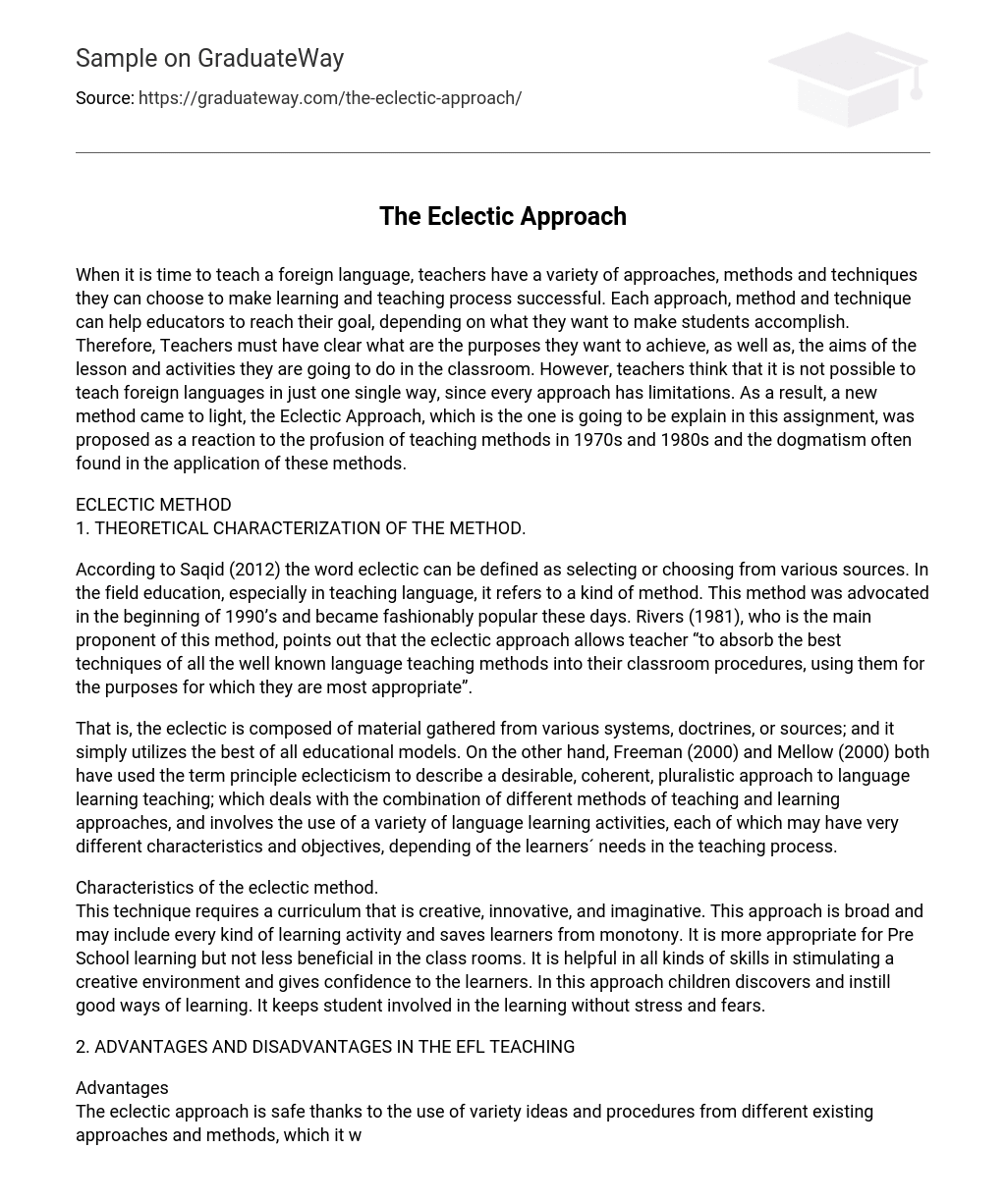When it is time to teach a foreign language, teachers have a variety of approaches, methods and techniques they can choose to make learning and teaching process successful. Each approach, method and technique can help educators to reach their goal, depending on what they want to make students accomplish. Therefore, Teachers must have clear what are the purposes they want to achieve, as well as, the aims of the lesson and activities they are going to do in the classroom. However, teachers think that it is not possible to teach foreign languages in just one single way, since every approach has limitations. As a result, a new method came to light, the Eclectic Approach, which is the one is going to be explain in this assignment, was proposed as a reaction to the profusion of teaching methods in 1970s and 1980s and the dogmatism often found in the application of these methods.
According to Saqid (2012) the word eclectic can be defined as selecting or choosing from various sources. In the field education, especially in teaching language, it refers to a kind of method. This method was advocated in the beginning of 1990’s and became fashionably popular these days. Rivers (1981), who is the main proponent of this method, points out that the eclectic approach allows teacher “to absorb the best techniques of all the well known language teaching methods into their classroom procedures, using them for the purposes for which they are most appropriate”.
That is, the eclectic is composed of material gathered from various systems, doctrines, or sources; and it simply utilizes the best of all educational models. On the other hand, Freeman (2000) and Mellow (2000) both have used the term principle eclecticism to describe a desirable, coherent, pluralistic approach to language learning teaching; which deals with the combination of different methods of teaching and learning approaches, and involves the use of a variety of language learning activities, each of which may have very different characteristics and objectives, depending of the learners´ needs in the teaching process.
Characteristics of the eclectic method. This technique requires a curriculum that is creative, innovative, and imaginative. This approach is broad and may include every kind of learning activity and saves learners from monotony. It is more appropriate for Pre School learning but not less beneficial in the class rooms. It is helpful in all kinds of skills in stimulating a creative environment and gives confidence to the learners. In this approach children discovers and instill good ways of learning. It keeps student involved in the learning without stress and fears.
Advantages and Disadvantages in the Efl Teaching
Advantages
The eclectic approach is safe thanks to the use of variety ideas and procedures from different existing approaches and methods, which it will increase the chances of learning taking place. This approach has interest involves, since teachers need to use different techniques to hold the learners’ attention. It is diverse because learning/teaching contexts require different methodologies. It is flexible since teachers can adapt their activities in each lesson depending on the learners´ needs. İt maximizes child’s passions for learning and accommodates child’s learning style It accomodates disabilities and it adapts to needs and abilities of learners.
Disadvantage
It can result unsuitable because there is any guide on what approaches and methods can be combined, what are the aspects and the basis; that is, there is no organization to carry out the learning-teaching process.
Roles of the Teacher and Learner According to the Eclectic Method
The roles of teachers are going to depend on the different methods she/he uses in the classes. First of all, teachers have to identify the strengths and weaknesses of their students; then based on that, they have to design classes and activities, which adapt to their students’ needs. So, taken into account this, the roles of the teacher is going to be acting as an observer, designer, planner, guider, facilitator and entertainer; which uses his authority to conduct the class and make the process of teaching and learning systematic. By contrast, the role of the learner is going to be demonstrating their knowledge and understanding, skills, attributes and capabilities through their participation in teaching/learning activities; and be cooperative and communicative with each other.
Teaching English is a process that requires of the combination of various methods and approaches, which will help them to teach English effectively; it is a process that only can be achieve through the eclectic method. The eclectic method allows teachers the use of techniques and activities from a range of language teaching approaches and methodologies. He/she decides what methodology or approach to use depending on the aims of the lesson and the learners in the group. Through this method, teachers can have the freedom of designing and evaluating different types of classroom lessons. Also, they may opt for combining two or more approaches; in such way, they can discover his own. But it just can be done when teachers have experienced with some of the approaches and put them into their teaching, hence assess their effectiveness. In the same way, this method allows learners to have a clear vision what they are learning, and it allows to blend the practices of listening, speaking, reading and writing in teaching/learning process; which will be achieved through multiple tasks, high interaction, lively learning, objective correlative and fast results; in order to do a unique process.





